TOPIC 3: SOIL CHEMISTRY | CHEMISTRY FORM 4
TOPIC 3: SOIL CHEMISTRY | CHEMISTRY FORM 4
(physical, chemical or biological) result to disintegration of rocks
into smaller particles. Air and water enter the space between these
particles and chemical changes take place, which lead to the production
of chemical substances. Bacteria and plant life soon appear.
organisms, especially bacteria. If any one of these is substantially
reduced in amount or is removed from the soil, then the soil
deteriorates. There are many types of soil and each has specific
characteristics related to the climate, the vegetation and the rock of
the region in which it forms. The weathering processes of a region also
play an important part in determining soil characteristics. The
relationship of these factors is as shown in figure 3.1.
about soil formation can lead to better soilclassification and more
accurate interpretation of soil properties.There are several factors
responsible for soil formation. Thefactors include climate, living
organisms, relief (topography),parent material and temperature. All the
factors, except time,depend to a greater or lesser extent upon each
other, upon the soilitself or upon some other factor. None of the
factors can beconsidered more important than any other, but locally one
factormay exert a particular strong influence. These factors
areexplained in details below.
materials are made up of mineral material or organic matter or a
mixture of both. The organic matter is usually composed predominantly of
unconsolidated, dead and decaying plant remains. The mineral material,
which is the most widespread type of parent material, contains a large
number of different rock– to form Climate which decays to form results
in weathering of influences the type of climate rocks vegetation humus
Climate Soil mineral soil Climate forming minerals and can be in either
consolidated or unconsolidated state.
rocks are more easily weathered than others. Acidic rocks are more
resistant to weathering than basic rocks. The parent rock affects soil
texture and water permeability.
rock with fine particles is more resistant to chemical weathering than
mechanical weathering. Very compact parent rocks like sandstone are very
much resistant to weathering. Porous rocks weather easily by chemical
processes. This is because they have large surface areas for weathering
agents to act upon.
is the principal factor governing the rate and type of soil formation
as well as being the main agent determining the distribution of
vegetation. The dead vegetations decay to form humus as one of the
components of the soil.
understand well the influence of climate on soil formation let us have a
look at its components and how each of these components affects soil
formation.
main effect of temperature on soil is to influence the rate of
reactions; for every 10°C rise in temperature, the speed of a chemical
reaction increases by a factor of 2 or 3 (twice or thrice). Temperature,
therefore, influences the speed of disintegration and decomposition of
the parent materials and its consolidation to form the soil.
water in soils includes all forms of water that enter the soil system
and is derived mainly from precipitation as rain. The water entering
soils contains appreciable amounts of dissolved carbodioxide, forming a
weak carbonic acid. This dilute, weak acid solution is more reactive
than pure water. It thus reacts with unconsolidated minerals and organic
matter, breaking them down into mineral (clay, sand) and organic debris
(humus) respectively.
organisms influencing the development of soils range from microscopic
bacteria to large mammals including man. In fact, nearly every organism
which lives on the surface of the earth or in the soil affects the
development of soils in one way or another. More important soil
organisms of interest to soil formation are as follows:
plants (particularly grasses) extend their roots into the soil and act
as binders. So they prevent soil erosion. The roots also assist in
binding together small groups of particles hence developing a crumby or
granular structure. Large roots are agents of physical weathering as
they open and widen cracks in rocks and stones. When plants die they
contribute organic matter to the soil, which acts as a binder of the
soil particles. Higher plants intercept rain and they shelter the soil
from the impact of raindrops. They also shade the soil and hence reduce
evaporation.
such as moles, ground squirrels and mice burrow deeply into the soil
and cause considerable mixing up of the soil, often by bringing up
subsoil to the surface, and creating burrows through which the top soil
can fall and accumulate within the subsoil.
include bacteria, fungi, actinomycetes, algae and protozoa. These
organisms act as decomposers of organic and even mineral matter.
include earthworms, nematodes, millipedes, centipedes and many insects,
particularly termites and ants. Activities of mesofauna include:
- ingesting organic mineral materials e.g. earthworms and millipedes;
- transportation of materials e.g. earthworms, millipedes, termites, beetles, etc; and
- improvement of soil structure and aeration.
- Cultivation
of soils for production of food and tree crops, which in many cases has
negative effects causing impoverishment of the soil and erosion. - Indiscrimate grazing, casual burning, cutting of trees, manure and fertilizer use, all of which alter the soil characteristics.
refers to the outline of the earth‟s surface. All land surfaces are
constantly changing through weathering and erosion. It may take millions
of years, in the case of Himalayas and the Andes, to be worn down to
flat undulating surfaces. The soils on steep mountain slopes are shallow
and often stony and contain many primary minerals. In areas where the
difference in elevation between the highest and the lowest point is
great, then climatic changes are introduced. These differences in
elevation, slope, slope direction, moisture and soil characteristics
lead to the formation of a number of interesting soil sequences.
formation is a very slow process requiring thousands and even millions
of years. Hence, it is impossible to make definite statements about the
various stages in the development of soils.This is because it takes a
considerable period of time for a particular soil type to be formed and
categorized.
reaction refers to how acidic or alkaline a soil is. It isexpressed as a
pH value. The soil can be acidic, neutral or alkaline. Extremely acidic
soils can have pH values below 4.5 and on the other hand, very alkaline
soils can have pH values up to,and even higher than 9.0.
all soils have pH values between 4 and 8. Soils with pH< 4 generally
contain sulphuric (IV) acid, while those with pH <8 contain a high
percentage of Na+ ions and thus they are alkaline.
= -log10[H+] where [H+] denotes the concentration of H+ ionsin
grams/litre. This is the same as saying that pH is the logarithmof the
reciprocal of [H+]:

greater the [H+], the lower the pH and the more acidic the soilis.
Acidic soils are common in humid regions, particularly thetropics, where
rainfall is sufficiently high to leach theexchangeable bases from the
top soil. Alkaline soils, on the otherhand, are characteristic of the
arid regions of the world where,because of low rainfall, there is a high
concentration of basiccations (Ca2+, Mg2+, Na+, etc) in the surface
soil layer. Generally,acidic soils occupy a large area of arable land
than alkaline soilsdo. Because of this, acidic soils are considered to
be moreimportant, at the practical level, as compared to alkaline soils.
known that the soil can be acidic and that the acidity is aresult of
great concentration of H+ ions in the soil, let us knowlook at the
causes of soil acidity. The causes of soil acidity includethe following:
- Leaching:
Heavy rains may leach bases like Ca2+, Mg2+, K+ andNa+ from the soil to
the ground water table, leaving a surplus ofH+(aq) in the soil. - Soil Microorganisms and root respiration produce carbondioxide which forms weak carbonic acid with the soil solution.
- Near industrial regions, acid rain (often pH 2–4) may bringsulphuric (IV) acid and nitric (V) acid to the soil.
- Acid
mineral fertilizers, like ammonium sulphate (VI) andammonium chloride
make the soil solution more acidic due to oxidation and hydrolysis:


the NH4OH produced by oxidation and hydrolysis dissociates further to
give NH4+ and OH– ions. The NH4+ ions produced undergoes microbial and
enzymatic oxidation (as show above) to release more H+ ions to the soil.

Organic acids produced during the decomposition of organic matter also
contribute to soil acidity. Due to such reasons, most soils in the humid
tropics are acidic.

simplicity and easy understanding, the equation for hydrolysis of Al3+
ions is sometimes represented in a single equation as:

above causes to soil acidity can be categorized as either natural or
artificial. The artificial causes are acid rain and acid mineral
fertilizers which are a result of deliberate human actions. The rest of
the causes are classified natural because they occur naturally.
pH of a soil can be tested by using Soil pH Kit. The kitcomprises of
equipment and dyes (pigments) that are employed insoil pH determination.

pH kit is simple to use and can be used many times. Colour indicator
dye and chart easily helps to find out pH. Knowledge of soil pH is very
important to a farmer. Most plants grow well in soils with pH ranging
between 5.5 and 7.5.
will need a clean trowel and a clean container for each sample you
take. You can use clean boxes, plastic bags, or any convenient container
to collect your sample. For powder-based kits you will need distilled
water for the test itself.
pH can vary in different parts of your garden either naturally or
through different types and levels of cultivation. You may be able to
see clear differences in colour, texture and humus content. Therefore,
aim to take a number of samples from different areas and test each one
separately.
each area you are sampling, scrape away the top soil to a depth of
about 5 cm. This prevents the reading being affected by any top
dressings or mulches you have applied or any accumulation of leaf litter
or pine needles.
break up the soil to a depth of about 12 cm and take the sample from
the bottom level. Collect more than you think you will need as you will
be picking out all the lumps, stones, twigs etc. Make sure you label
each sample so that you know where they have come from.
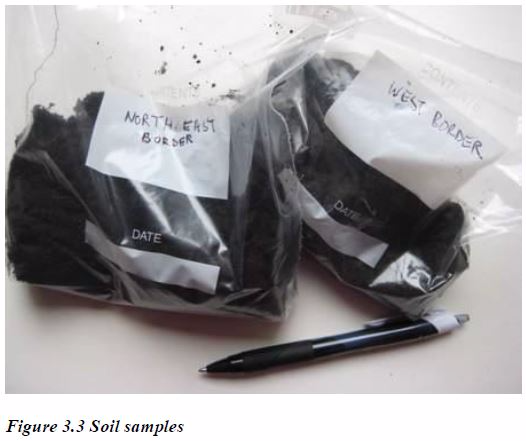
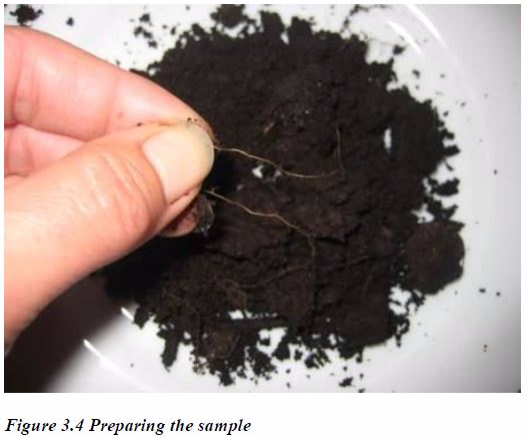
Break up the dry sample with the back of a clean teaspoon or the tip of
a clean trowel, and place the specified amount in the test tube or test
chamber provided.
stage will vary depending on the type of kit you have purchased.Before
going any further, it is important to note that soil pH test is purely a
qualitative test. In this test, barium sulphate is often used as a
reagent.
sulphate is used in soil testing as a flocculant. It causes the fine
soil particles to clump together and sink, leaving a clear test
solution. This enables you to make an accurate colour comparison. If you
have a clay soil with lots of fine particles you may need to add extra
barium sulphate to clear the liquid. This is another advantage of
liquid-based tests where the barium sulphate powder is provided
separately.
your kit contains a liquid test solution, you will usually have to add a
scoop of the provided barium sulphate powder to the sample followed by
the specified amount of test solution. If you have a clay-based soil it
is useful to add extra barium sulphate right at the start. Put the cap
on the test tube and shake it well. Leave it to settle for the required
time, normally 10 minutes.
kits containing the reagent in powder form you will have to add the
specified quantity of powder (this usually contains the appropriate
amount of barium sulphate as well as the reagent) followed by the
required amount of distilled water. Put the cap on the test tube and
shake well to mix. Allow to settle for the specified time, usually
around 10 minutes.
the resulting colour of the solution against the supplied colour chart.
Don’t leave the solution for much longer than the stated time because
the colour may start to change and you won’t get an accurate result. Try
to do this in good natural light but away from bright sunlight to make
an accurate comparison.The following are the results obtained from two
soil samples tested: The sample from the West Border (above) is neutral
(it is neither acidic nor basic).
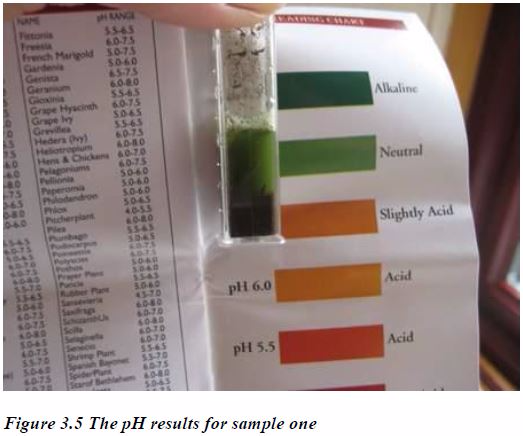
soil sample from the North-east border, however, was found to be
acidic, with pH 6.0. The soil contains a lot of organic matter, such as
garden compost and rotten manure, which tends to lower soil pH, making
it more acidic.
both soils fall well within the pH range (5.5 to 7.5) acceptable to
most plants so the farmer can just carry on with farming as before.
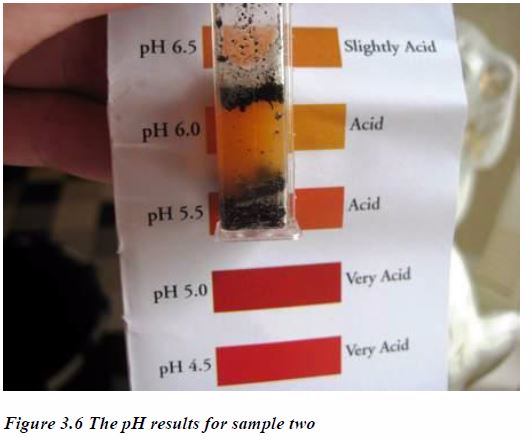
of the soil pH is important because it helps to identify the pH of
different soils and hence making the correct decision on different kinds
of crops that can be grown on a soil with a particular pH.
growth is affected by the acidity or alkalinity (pH) of the soil. Soils
with high peat content, or with minerals such as iron compounds, or
with rotting vegetation and lack of oxygen, tend to be acidic. Their pH
can reach as low as pH 4. Soils in limestone orchalky areas are alkaline
(up to pH 8.3). Different plants prefer different pH conditions.
Farmers and gardeners can test the soil pH to see whether it suits the
needs of particular plants. An example of preferred soil pH conditions
for different crops is given below:
| Crop | Preferred pH |
| Irish potato | 4.5 – 6.0 |
| Chicory, parsley | 5.0 – 6.5 |
| Carrot, sweet potato | 5.5 – 6.5 |
| Cauliflower, garlic, tomato | 5.5 – 7.5 |
| Broad bean, onion, cabbage and many others | 6.0 – 7.5 |
the soil is strongly acidic (pH < 5), most crops will give only very
poor yields if any. In such a soil, the acidic H+(aq) and Al3+(aq) ions
prevail while the basic nutrient ions such as Na+, Mg2+. Ca2+, etc are
not sufficiently available.
order to raise the pH of such a soil, basic compounds of calcium and
magnesium are added and mixed well with the top soil; e.g. the oxides,
hydroxides, carbonates and silicates of calcium and magnesium, commonly
called agricultural limes. All these compounds have the effect of
neutralizing the acidity of the soil. If the soil is too alkaline, it
helps to dig
lime is added to an acidic soil, the liming material usually reacts
with the water and/or with the carbonic acid in the soil and dissolves
e.g:

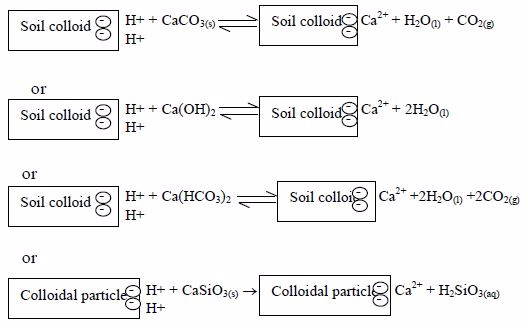
by liming an acid soil, the percentage base saturation and the pH of
the soil is raised and carbon dioxide is produced. The amount of lime
needed depends on the pH of the soil, its texture, structure and its
content of organic matter.
that is, raising the soil pH to above 7.5, is a danger especially in
soils of low cation exchange capacity and hence low reserve acidity. It
reduces the availability of P, K, Fe, Mn, B and Zn often so much that
crops suffer from the deficiencies of these nutrients. Often, crops
become stunted and turn yellow. Therefore, overliming must be avoided by
all means.
are those mineral nutrients that are required by plants in greater
amounts. They constitute about 99% of plants‟ requirements.
also referred to as major nutrients are further divided into primary
and secondary macronutrients. Primary macronutrients are the elements
that are required by plants in relatively large quantities (60% of the
plant‟s requirements). They are nitrogen, phosphorus and potassium. The
secondary macronutrients are calcium, magnesium and sulphur. These
elements contribute the remaining 39% of the plant‟s needs
also referred to as trace elements, are those mineral nutrients that
are required by plants in smaller amounts. They constitute about 1% of
plants‟ requirements.
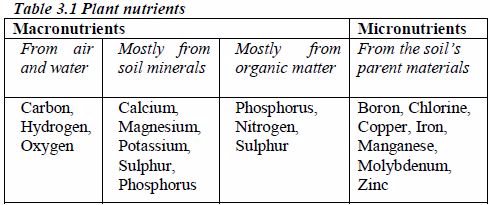
use the sugars for energy supply and to produce cellulose (for the cell
walls) and starch (for storage). Proteins are made from sugar and
nitrogen. They are used to synthesize protoplasm which is vital for the
plant cells.
for some gaseous carbon dioxide, oxygen and sulphur dioxide, all
nutrients enter the plants in the form of ions usually from the soil
solution through the roots.
metals are absorbed by the plant roots in the form of their cations.
Nitrogen is taken in as ammonium or nitrate (V) ions; phosphorus as
dihydrogenphosphate (V) ions; sulphur as sulphate (VI) ions and chlorine
as chloride ions.
nutrient ions move towards the plant roots either with the flow of the
soil solution (since the roots also take in water) or by diffusion. The
ions diffuse from areas of high concentration to those of low
concentration caused by the intake by the roots.
roots either absorb equal numbers of positive and negative charges in
the form of ions from the soil solution or they exchange one ion against
another one with the same charge, usually H+ or OH–. Thus, roots
possess electrical charges on their surfaces which can hold and exchange
ions.
essential plant nutrients perform specific functions to aid plant
growth or reproduction. They must all be available in the right
proportion to facilitate optimum plant growth.
carbon and oxygen are taken in by plants through the stomata in the
form of carbon dioxide from the air. Thus, they are never in scarce
supply. Hydrogen (and oxygen) is supplied by water
in the plant: in the presence of sunlight, the green parts of the plant
synthesize carbohydrates (sugars) from carbon dioxide and water.
only ammonium and nitrate (V) ions are available to plants. Usually
about 98% of a soil‟s nitrogen is available (in organic matter). Organic
matter decomposes by microbial action to form NH4+. This process is
called ammonification. Almost any microbe can carry out ammonification.
is another process called nitrification, which is carried out only by a
few specific bacteria e.g. nitrosomanas. Nitrosomanas bacteria oxidize
ammonium ions to nitrate (V) ions:

few living organisms can fix nitrogen from the air. The best known are
rhizobia (legume bacteria) and the free living bacteria such as
azotobacter and clostridium, also the blue-green algae.
needs: plants need more nitrogen than any other nutrient. However,
their needs vary greatly: plants with high vegetative growth (stems,
leaves, etc) have high N needs (maize, sorghum, rice, sugar cane,
pasture grasses, most vegetables). Root crops (cassava, sweet potatoes,
taro) have lower N needs. Legumes (alfalfa, desmodium, kudzu, all types
of beans and peas, ground nuts, etc) may not need N fertilization if the
proper strain of rhizobia is fixing N for them.
It is used to build amino acids, nucleic acids, many enzymes, chlorophyll, generally speaking: all proteins.
It
promotes the vegetative growth in plants. It is therefore important in
the growth of plants in which leaves are harvested, such tobacco and
vegetables.
It is an essential element in cell division. It is therefore needed for plant growth.
It increases grain size and protein content in cereals.
It promotes root growth.
symptoms: leaves turn yellow and finally die, because chlorophyll can
not be build up. Then due to lack of chlorophyll the plant grows slowly,
because the chlorophyll is needed for carbohydrate production. The
shortage of chlorophyll is called chlorosis.
nitrogen: excess nitrogen causes dark green succulent vegetation with
weak stems, often at the expense of seed or fruit production, e.g. in
grain crops, in tomatoes and beans.
causes the potatoes to be watery. It delays crop maturity, and makes
plants more vulnerable to attack by diseases and pests. Thus,
fertilizers must be carefully dosed.
N is easily leached since NH4+ is rapidly nitrified in a warm climate,
and NO3– is not adsorbed by soil colloids. Thus, it is important to
apply fertilizer at the right time in order to avoid leaching.
- Phosphorus
is an essential component of the genetic material of the cell nucleus
(RNA, DNA); also in ADP and ATP, which play a vital role in
photosynthesis, amino acid and fat metabolism, etc. - It increases the grain yield e.g. of millet, sorghum and rice because it promotes the formation of tillers.
- It promotes root growth.
- It strengthens the resistance of plants to diseases.
- Also rhizobia bacteria need it in order to fix nitrogen from the air.
- It hastens plant maturity.
- Dark green colouration
- Purple spots or streaks.
- Stunting, delayed maturity.
only the K+ ions of the soil solution are available to plants. Hydrated
potassium ions attached to soil colloids are readily available because
they are not bonded strongly to the surface of the colloids.
nitrogen, potassium is the second-most element needed by plants. Starch
and sugar crops (cassava, sweet potatoes, banana, sugarcane) have
relatively high needs of K.
in plants. Potassium is present in plants in the form of it ions only.
It does not form any integral part of the structure of any known organic
compounds in plants.
- Potassium
is an activator of a number of enzymes involved amino acid synthesis
and several enzymes concerned with carbohydrate and nucleic acid
metabolism. - Potassium aids in the uptake of other nutrients and
in their movements within the plant e.g. potassium ions and nitrate (V)
ions may move together. - Potassium is also important in the
metabolism of carbohydrates and translocation of food. Thus, it promotes
starch and sugar formation. - It regulates osmosis in cells, improves tissue formation and assists in protein synthesis.
- It strengthens plant stalk, hence preventing lodging and microbial attack.
- Stunting:
First the edges of the older leaves and then areas between veins turn
yellow and finally brown. Small, brown necrotic spots develop while the
veins are still green. - Leaf curling and premature leaf fall.
potassium chloride, potassium sulphate, potassium nitrate. Wood ashes
and their aqueous extract (potash) contain potassium carbonate. Tobacco
stems contain about 5% potassium, and cocoa shell meal about 3%.
only Ca2+ ions in the soil solution are available to plants. Calcium
comes from CaCO3 (calcite), gypsum (CaSO4·2H2O), apatite and other
minerals.
- Calcium is a constituent of cell walls and hence makes the straw stiff and resistant to lodging.
- It is essential for cell division.
- It promotes early root and seed development.
- It regulates the intake of potassium by plants.
- It neutralizes harmful organic acids like ethanedioic (oxalic) acid in plants, thus detoxifying them:

- Magnesium
is vital to the production of chlorophyll, because every molecule of
chlorophyll contains a magnesium ion at the core of its complex
structure. Most of the magnesium in plants is found in either
chlorophyll or seeds. A lesser part is distributed in other parts. - Aids in the translocation of carbohydrates.
- Regulates the uptake of other nutrients.
- Part of the distributed magnesium functions in the enzyme system involved in carbohydrate metabolism.
Mostly dolomitic limestone (CaCO3·MgCO3). The principal magnesium
fertilizer is magnesium sulphate (VI), sometimes known as epsom salt. It
is soluble in water and can be sprayed onto the leaves.
- Sulphur is a vital part of plant proteins since cystine and methionine are sulphur-containing amino acids.
- Sulphur is also essential for the action of enzymes involved in nitrate (V) production.
deficiency symptoms resemble nitrogen deficiency symptoms because both
are related to protein and chlorophyll deficiency.
gypsum and elemental sulphur, both of which are also used to lower soil
pH; ammonium sulphate, superphosphate potassium sulphate (VI).
In igneous rocks, iron occurs in the Fe2+ form. The iron in
water-logged soils tends to remain in this form and contributes to the
bluish-grey colours that indicate wetness. Much of the iron in well
drained soils is in the Fe3+ form and is associated with humus and
mineral particles.
is an essential catalyst in the formation of chlorophyll and functions
in some of the enzymes of the respiratory system. Iron is needed in
larger quantity than all other micronutrients.
Iron (II) sulphate (FeSO4) which is soluble in water. Application of
iron is generally ineffective to calcareous soils.
Micronutrients are taken in by plants as Bo2–, Co2+, Cu2+, Mn2+, MoO2–
and Zn2+. The micronutrients in the soil usually originate from the
parent material of the soil. Plant needs of these micronutrients are
very small.
- Manganese
is a catalyst in the formation of chlorophyll and in many redox
reactions, e.g. metabolism of nitrogen, iron, copper, zinc and in
vitamin C synthesis. - Boron aids protein synthesis, regulates the K:Ca ratio in plant tissues and is required for the formation of roots and fruits.
- Copper is involved in respiration and in the nitrogen and iron metabolism.
- Molybdenum is essential in the protein synthesis and for the nitrogen fixation by rhizobia on the roots of legumes.
- Zinc
catalyses the formation of growth hormones and promotes the synthesis
of RNA and chloroplasts. Thus it is essential for normal growth. - Chlorine seems to be essential in photosynthesis and is required for plant growth.
- Cobalt
is essential for nitrogen fixation by rhizobia and hence aids growth of
legumes. However, it is not clear whether it is essential for growth of
higher plants.
Large amounts of micronutrients are usually toxic to plants. The best
method of application is usually foliar spraying.
cultures are prepared in the laboratory by using chemicals such as
CaSO4, Ca3(PO4)2, MgSO4 and KNO3. These salts are dissolved in water to
make cultures containing ions of plant mineral elements. Different
cultures lacking some mineral nutrients are made and used to grow
plants. The health of plants in various cultures is compared with those
grown in a culture with all elements.
plants take up nutrients from the soil continuously. To maintain the
soil fertility, the nutrients taken by plants must be replenished
(replaced). There are several methods that when combined at least in
some aspects can help raise or maintain soil fertility. These are:
are mostly inorganic compounds which contain one or more plant
nutrients in a concentrated form. They help to increase or maintain
fertility if used carefully with a good background of knowledge.
However, if used without proper knowledge or advice by agricultural
officers they can be harmful to the soil, crops, animals and humans.
should also be noted that without reasonable humus content, the soil
may have such a low cation exchange capacity that most of the applied
fertilizer is leached from the soil instead of being available to
plants.
just adding fertilizer on a field without good cropping system and,
advisably, with addition of manure is often a waste of money, time and
energy.
- biogas manure – from biogas plants-
- farm yard manure – from wastes of farm animals such as cattle, sheep, goats, poultry, pigs, donkeys, etc;-
- compost manure – from decomposed organic matter; and-
- leguminous
green manures, like sunhemp, beans, cowpeas, groundnuts, peas, etc.
These young plant materials when ploughed and incorporated into the soil
provide organic matter and nitrogen.
plant nutrients are concentrated on the top soil. If this soil is
eroded the nutrients are lost too. This can be stopped by taking soil
conservation measures which include mulching terracing/ridging, deep
tillage, contour ploughing, strip cropping, planting shelter belts or
windbreaks, reforestation, avoiding overgrazing and overstocking, etc.
refers to the practice of planting different crops in a field in
successive growing seasons. A good crop rotation is that which include
leguminous crops (which fix nitrogen in the soil) followed by
non-leguminous crops and vice-versa.
refers to the act of planting two different crops (preferably legumes
with non-legumes) on the same field. Legumes provide nitrogen to
non-legumes and the non-legumes help to cover the soil to prevent
erosion.
refers to mixed cropping of e.g. cereals and usually leguminous trees
like Leucaena leucocephala, which provide nitrogen to the field. The
trees take up nutrients from the deeper layers of the soil while the
cereals take up their nutrients from the top layers. Leguminous trees
provide the cereals with the humus when their leaves fall and rot on the
soil. They also provide forage for animals, and firewood. Agroforestry
is also one of the protections against soil erosion.
remnants harvest should not be burnt down but they must be ploughed and
incorporated into the soil. This will help to maintain adequate levels
of organic matter in the soil and hence reduce soil erosion. Also by
burning crop residues, valuable plant nutrients (N, P and S) are lost
and the chance to increase humus level of the soil is reduced.
refers to loss of plant nutrients from the top to the bottom soil
layers, following heavy rains or overirrigation. This can partly be
stopped or reduced by maintaining adequate levels of soil organic matter
to trap the nutrients and also by avoiding too much irrigation. It can
also be stopped by avoiding overcultivation, a fact which makes the soil
too loose that the nutrients are easily percolated with the soil
solution to the bottom soil layers making these nutrients unavailable to
plants.
refers to leaving the land idle to rest, a fact which allows the land
time to regain its lost fertility. However this practice is only
possible for farmers with plenty of land. It was an equally good
practice in the past when human population was low as compared to
vastness of the land at that time. It is not widely practiced today
except in areas with low population density and abundant arable land.
soil conservation measures such as terracing, contour ploughing,
mulching, deep tillage, etc. will help maintain soil fertility.
crops are suited to different soil types. If you plant crops in a wrong
soil you are likely to weaken that soil and destroy its fertility
status. But if appropriate crops are planted in the right soil type,
chances of maintaining or sustaining the fertility of that soil is also
very high.
of appropriate soil amendment practice such as liming, acidification,
conversion, etc helps to maintain soil fertility. For example, liming is
good as it corrects soil acidity but if too much lime (overliming) is
applied it results to another problem of setting on soil alkalinity.
Likewise, an acid soil, no matter how much beneficial nutrients it
contains, is of no use unless its acidity is corrected
dependence and overuse of agrochemicals such as pesticides, herbicides
and inorganic fertilizers unnecessarily. These chemicals must be used
with care and only where agricultural production is impossible without
their application. This is because they contribute a great deal to soil
pollution and toxification of beneficial soil organisms.
balance of nutrients in the soil must always be maintained. Plants
usually require specific quantities of different nutrient elements.
These nutrients must be maintained in the soil by good cropping systems,
application of appropriate fertilizers and manure and adopting good
soil management practices.
refers to any natural/manufactured/synthetic materials that contain at
least 5% or more of one or more of the primary plant nutrients/element
(N, P or K). Examples of fertilizers include ammonium nitrate, sulphate
of ammonia, CAN, NPK, etc.
refers to any fertilizer material, from plant or animal bodies or
wastes. Examples of manures include farm yard manure (from domesticated
animal wastes), green manure (from young green leguminous plants), and
heap and compost manure (from decomposed plants). Manures are sometimes
called organic fertilizers.
- Dig compost pit;
- Place dry plant materials. Sprinkle enough water;
- The next layer will be composed of green plant materials or any refuse
- Top this with a mixture of animal manure, soil, and ash;
- Repeat steps 2-4 until the pile reaches a height of 1 m;
- Cover the pit with broad-leaved plants;
- Turn the pile every two weeks. The compost is ready after 3-4 months.
- They
add nutrients to the soil and at the same time improve soil physical
properties such as soil colour, soil structure and water holding
capacity of the soil. A soil with good content of organic matter
(supplied by manure) holds water and dissolved nutrients efficiently
making them available to crop plants. - Manures supply humus to
soil which, in turn, increases the cation exchange capacity of the soil.
Humus accounts for 30–90% of the cation exchange capacity of mineral
soils. And because of its high cation exchange capacity, humus helps to
store nutrient cations, especially ammonium ions, thus reducing the
leaching of these nutrients from the soil. - Manures improve the
proliferation of the soil macro- and microorganisms by supplying the
nutrients and conducive conditions needed by these organisms for
survival. These organisms play a vital role in soil fertility and plant
nutrition by decomposing organic matter which releases nutrients to the - Manures
provide organic matter which acts as the binding materials for soil
particles, making them more compact and hence resistant to the impact of
rain drops and surface run off of water. Thus, it reduces soil erosion. - Manures
can remain in the soil for a long time and they can provide the
nutrients to crops for several growing seasons. Its nutrients are
released slowly over a long period of time - They do not change the soil pH greatly as the inorganic fertilizers do.
- Humus
from organic matter is dark in colour and imparts this black
colouration to the soil. Black colour absorbs more heat and hence helps
to regulate soil temperature.
- Manures
contain and provide little nutrients per unit volume and weight. One
has to apply tremendous amounts of manure to meet the requirements of
plants. - Their bulkiness and volume makes it difficult to store,
handle or apply in the field. It requires more space to store or
transport and more labour to apply manures in the field. - Some
kinds of manures e.g. sludge or industrial and municipal wastes may
contain toxic chemicals which can harm humans, animals or soils to which
it is applied. - Manures act very slowly in that they release nutrients to the soil at a very slow rate.
- If
the plant materials used to make manure is infested with plant pests or
weed seeds; or infected with diseases, there is a risk of spreading
them to the farm. - Manures easily lose nutrients if stored
improperly. Under hot conditions, manures produce a lot of heat that
leads to loss of136nitrogen through vapourization. Soluble nutrients are
easily leached
in different parts of the country use different fertilizers (depending
on soil conditions) to improve soil fertility. Examples of fertilizers
used by farmers in Tanzania include:
Sulphate of ammonia, (NH4)SO4;
Calcium Ammonium Nitrate, CAN;
NPK;
Superphosphates;
Ammonium chloride, NH4Cl;
Urea, CO(NH2)2
Ammonium nitrate, NH4NO3;
Potassium sulphate, K2SO4
Potassium chloride, KCl; etc.
fertilizer is any substance containing plant nutrients that is usually
added to soil to supplement the required plant nutrients. Chemical
fertilizers may be natural or synthetic. Natural inorganic fertilizers
would include materials such as Chile saltpetre (NaNO3), rock phosphate,
potassium chloride (KCl), etc. Synthetic fertilizers are manufactured
products, such as urea, ammonium sulphate, ammonium phosphate, single
superphospahte, etc.
fertilizers are available in various grades and analyses. A complete
fertilizer has all three primary fertilizer ingredients (N, P and K) as
part of its formulation. For example, 14 – 15 – 14 is a complete
fertilizer. This fertilizer has 14%N, 15%P and 14%K.
- Single nutrient fertilizer or straight fertilizers: These are fertilizers containing only one of the primary nutrient elements.
- Double nutrient fertilizer: These contain two primary nutrient elements.
- Complete fertilizers or complex fertilizers: These are materials that contain all three primary elements, N, P and K.
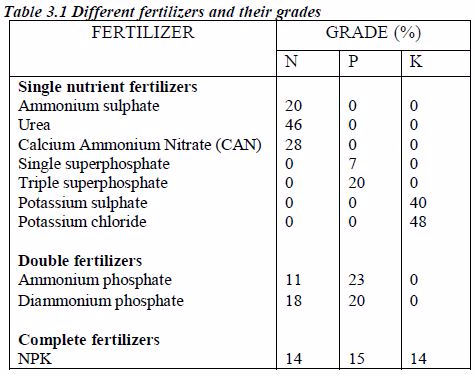
most of the commercials fertilizers P is expressed as P2O5 and K as
K2O. To convert P2O5 to P, multiply the value by 0.437 and to convert
K2O to K, multiply the value by 0.830. However, in table 3.1 the
nutrient contents are given in elemental form, N, P and K.
nutrient fertilizer grade indicates that everything in a bag of
fertilizer is not plant nutrient. Much of the material in the bag is
made up of filler materials. For example, ammonium sulphate contains
20%N. That means, 100 Kg of ammonium sulphate will contain 20 Kg of N
and the remaining 80 Kg is sulphate and filler material.

this background about fertilizer material, we need to calculate the
amounts of each nutrient source to meet the fertilizer recommendations.
Fertilizer recommendations are expressed in kilograms of nitrogen (N),
phosphorus (P) and potassium (K) per hectare. Fertilizers available in
the market also contain carrier and filler materials in addition to N,
P, or K. Hence, there is need to compute the amount of fertilizer
required to supply the recommended rate of nutrients.For example, if 90
Kg of N is recommended for sorghum, we must convert this recommendation
to Kg of urea or some other N fertilizer to be applied.
certain soil requires 80 Kg of N per hectare so as to fulfil
plantrequirements of nitrogen. Calculate, in kilograms, the quantity
ofammonium sulphate fertilizer required to meet this demand.
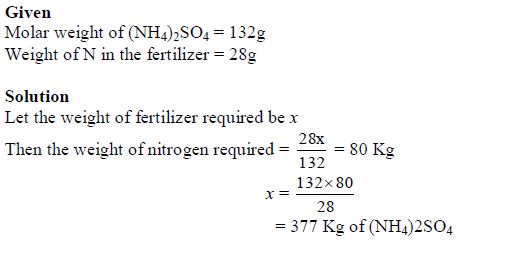
can be applied in several ways. The most importantpoint to remember is
to apply them at the proper rate, asoverapplication can result in plant
damage or death. Follow soilrecommendations or manufacture‟s directions.
Some of thecommon fertilizer application methods are as follows:
refers to spreading the fertilizer uniformly over theentire area before
planting and then incorporating it into the soil.Application of high
rates of the major nutrients namely, nitrogen,potassium and phosphorus
is usually carried out by broadcastingwith a tractor-mounted fertilizer
spreader. This allows a specific amount of fertilizer to be spread over
the entire under-tree area or in band along the row.
of the application rate for the various fertilizers which are used is
important. If calibration is not done properly, the quantity applied may
be considerably different to the desired rate.
after spreading, the fertilizer should be covered with the surface soil
to a depth of 4 to 6 inches or alternatively watered in. On alkaline
soils, prompt incorporation into the soil profile is vital for
nitrogenous fertilizers as they are readily lost into the atmosphere
(volatized) in the form of ammonia if left exposed on the soil surface.
- In soils whose fertility status is extremely low;
- In closely spaced crops such as rice, wheat, pasture, millet, etc;
- If the fertilizer used is in fine particles (granules or powdered); and
- If the field is properly prepared and is in good tilth.
refers to the application of nutrients through an irrigation system. In
this method, liquid fertilizers such as liquid ammonia, nitrogen
solutions, phosphoric acids and even complete fertilizers are applied to
the soil via irrigation water. The nutrients are spread onto the soil
in solution and then carried down with the infiltrating water. It
provides a simple and effective way to supply nutrients, particularly
nitrogen and potassium. Most trickle, jet, spray and sprinkler systems
can be used. Do not attempt fertigation using flood or furrow irrigation
as the distribution of nutrients will be uneven and leaching will
occur.
has the advantage of supplying nutrients to the area of greatest root
activity that is, the irrigated part of the root zone.Depending on the
irrigation system used, applications of fertilizer may need to be split
over several irrigations. This also improves the percentage taken up and
utilized by the plant. Frequent applications are easy to apply and
there is no soil compaction problem as would be the case with
broadcasting with a tractor.
injecting a nutrient into an irrigation system ensure that the form
being used is suitable. Some nutrients are readily soluble in irrigation
water while other nutrients must be specially formulated for
fertigation. For example, most forms of phosphorus are not suited to
fertigation as they tend to precipitate out and block the small orifices
of irrigation emitters.
refers to spraying a dilute nutrient solution directly to the plant
leaves. Foliar application is used for the correction of trace element
deficiencies. It should not be relied upon to supply the total nitrogen,
phosphorus, and potassium needs of plants. Commonly required foliar
sprays are zinc and manganese. Foliar application has the benefit of
rapid response as the nutrients are taken into the plant quickly. Foliar
applications of micronutrients, especially iron, may be beneficial when
high soil pH conditions make the iron unavailable to plant roots.
foliar applications are more effective in correcting trace element
deficiencies than soil applications. Trace elements are frequently tied
up by unfavourable soil condition so that nutrients applied to the soil
are bound before the plant can utilize them while foliar application
bypasses this problem.Foliar spray can also be used to alleviate
deficiency of major elements. This is will provide only temporary relief
and should be used only as a quick fix to minimize yield or quality
loss due to a sudden deficiency. It is not possible to apply the
quantity of the major nutrients that growing plants require by foliar
applications. Soil applications should provide over 90% of the quantity
of each major nutrient.
refers to placement of fertilizer 2 to 3 inches to each side and below
the seed at planting. This technique is risky as placement too close to
the seed or at high rate can cause fertilizer burn and inhibit
germination.
where the amount of fertilizer to apply is limited;
for widely-spaced crops;
when small labour is required ; and
in seedbed preparation.
refers to placing the fertilizer beside the row during the growing
season. This technique is usually used to apply additional nitrogen
during the growing season and is particularly useful for applying
nitrogen on sandy soils.
is similar to side-dressing except that the fertilizer is applied
around the plant. Care must be taken not to apply the fertilizer too
close to the plant as this can cause fertilizer burn.
solution fertilizers are soluble in water and they are usually high in
phosphorus. They are applied as liquid around the plant roots at the
time of planting. They are primarily used for vegetable transplants to
hasten root development and establishment. Follow manufacturer‟s
directions for application rates.
- They contain more nutrients per unit volume and weight.
- They are compact and hence easy to transport, store and apply to the field as compared to manures which are bulky in nature.
- They
contain specific quantities of plant nutrients per unit volume and
weight. So the quantity of a particular nutrient to be applied to the
soil can easily be estimated to avoid overapplication. For example the
weight of nitrogen in a kilogram of NH4NO3 can easily be established and
quantified. - They dissolve quickly and hence provide nutrients to plants instantly as they are added to the soil.
- They
are used only for one growing season as they are short-lived. Because
the uptake of the nutrients in the fertilizer is very high, no or few
nutrients would have remained in the soil in the next growing season. - Some
acidic mineral fertilizers such as NH4Cl and (NH4)2SO4 contribute to
soil acidity. When these fertilizers are applied to the soil repeatedly,
they can make the soil acidic and hence not fit for plant growth. - Prolonged use of artificial fertilisers may lead to deterioration of the soil structure and poisoning of soil and soil microbes.
- Extensive
use of fertilizers may cause contamination of drinking water resources,
by especially nitrate fertilizers. Nitrates dissolved in water are not
removed by normal purification processes. In the body nitrates may be
converted into nitrosamines. These are carcinogenic (cancer-causing)
compounds - If too much nitrogenous fertilizer is used, serious
pollution can occur. One kind of pollution is called eutrophication.
Excess of the fertilizer applied finally finds its way to water. This
encourages fast growth and huge increase in the number of microscopic,
aquatic plants called algae, a phenomenon called algal bloom.
Proliferation of algae on the water surface blocks sunlight from
reaching the plants beneath the water. These plants can not carry out
photosynthesis and, therefore, they die. Bacteria and other decomposers
feed on these dead plants and increase in number. These decomposers use
up all the oxygen dissolved in the water. Without ample supply of oxygen
fish and other organisms living in the water die. - They can
scorch (burn) and kill crop plants if not applied under manufacture‟s
directions or even harm humans if not properly handled. - Fertilizers are expensive to purchase and hence not affordable.
fertility is the ability of the soil to supply the essential nutrient
elements in adequate amounts, forms, and proportions for maximum plant
growth.
Chemical
soil fertility: this is the fertility due to chemical processes that
contribute to soil fertility. The chemical soil fertility falls under
two categories namely,(i) potential chemical fertility, due to cations
in soil solution; and(ii) active chemical fertility, which is due to
exchangeable cations adsorbed to the soil colloidal surface or
negatively charged plant roots.
Physical soil fertility: the fertility contributed by soil moisture, texture, structure, temperature, etc.
Biological soil fertility: this is due to organic matter content, and soil microorganisms.
productivity is the capacity or ability of a particular soil to sustain
plant growth and development. It is measured in terms of yield of a
particular crop which is a reflection or consequence of nutrients taken
up by plants from the soil. Soil productivity is an interaction of three
main factors.
Soil
fertility. This refers to the ability of the soil to supply the
essential plant nutrients required for maximum plant growth.
Plant
factors. These includes yield potential, root growth characteristic and
genetic make up of a particular crop plant. This means that some crop
plants are high-yielding than other plants of the same species and are
thus likely to give more crop yields. Also plants with good root
development are likely to absorb more nutrients from the soil, grow
better and give good yield as compared to plants with poor root
development. Genetic make up of a plant also plays a vital role in this
respect. For example hybrid maize will always survive harsh146soil and
environment conditions than local varieties of maize and, therefore,
will give high yields.
Environment factors. These factors
include climatic factors and agronomic practices.Climatic factors –
These are factors such as temperature, precipitation (rainfall),
radiation, humidity, altitude, etc.Agronomic practices include weed
control, pest and disease control, good soil preparation, plant
population, etc. Yield can be measured in terms of grain yield, tubers
yield, dry matter, height of plants, number of leaves, number and size
of fruits, berries, etc.
It has adequate water retention capacity;
It is well aerated; and
It is able to supply adequate amounts of the nutrients to plant.
retention capacity is influenced by soil organic matter, soil texture
(loam, clay, sand, etc), soil structure, and proportions of macro and
micro pores in the soil. Aeration is influenced by soil structure and
texture.
have learned that soil productivity depends on soil fertility in one
way or another. However, plant and climatic factors have their roles
play too.
this point of view, therefore, it is correct to assert that a fertile
soil is not necessarily productive simply because soil productivity does
not rely singly on the fertility of the soil. It depends on several
other factors such as soil moisture, which is determined by climate and
even altitude, which influences plant development a great deal. In
concise, it should be understood that there are several other factors
apart from soil fertility which affects the productivity of the soil.
Even soil management practices can affect soil productivity to a large
extent. Soil fertility is accounted for by the type and quantity of the
nutrient elements present in a particular soil which are available to
crop plants.
productivity is a measure of the amount of harvest or yield that can be
obtained from a given piece of land under certain agronomic conditions
and practices. For example, suppose a farmer grows maize on one acre of
plot A and manages to harvest 20 bags of maize. On another one-acre
plot, plot B, he harvests only 10 bags of maize. Of the two plots, A is
said to be more productive than B. This is one among many means for
determining soil productivity.
fertile soil provides all essential plant nutrients in amounts and
proportions which are suitable for growth of most plants. Soil fertility
depends on a number of factors, namely:
affects water and nutrient storage, and aeration. The soil with a fine
texture such as clay contains small airspaces. The movement of air in
and out of such a soil is thus minimal. However, these soils have a
great capability of holding water and nutrients. Its structure can be
corrected by addition of organic matter, such as farm yard manure and
compost, and heap manure.
the other hand, soils having a coarse texture such as sand are quite
porous. Sand allows water to pass through it very quickly. It is poor at
water retention and nutrient storage. It has wide air spaces and thus
well aerated. It can also be improved by adding organic manures.
deeper the soil the better the plant root development and the greater
the water and nutrient supply potential it has. Shallow soils do not
normally allow roots to penetrate deep through the soil. This leads to
poor root development and poor plant growth.
chemical composition of the parent material of the soil provides the
natural inorganic nutrient supply due to minerals present. A soil formed
from the decomposition of limestone will probably contain reasonably
high concentrations of Ca2+ ions in their exchangeable sites due to
inherent Ca2+ ions derived from limestone. The same case can apply to
high contents of nitrogen and phosphorus in humid soils due to high
decomposition of organic matter. The soil organic matter helps to cement
the soil particles therefore aiding to create a crumbly structure which
is ideal for most agronomic practices.
depends very much on the content of the soil and soil pH. A soil well
supplied with organic matter has an optimum cation exchange capacity.
The cations adsorbed to the soil colloids are easily exchanged with
those in the soil solution. Also humus contains humic (organic) acids
which can donate protons if the pH is low.
affects nutrient storage and availability. The availability of N, P, K,
S, Ca, Mg, and Mo decreases with increase in soil acidity. Below pH 5
and above pH 7, Al3+ and Fe3+ ions form complexes with soluble
phosphates so that the phosphates are no longer available to plants.
This is called phosphorus fixation. Below pH 4.8, Al3+ becomes so
soluble that it appears in high concentrations in the soil solution
which are detrimental to most plants. This aluminium toxicity is a
problem in some tropical soils.
climate affects water availability, temperature, weathering as well as
the physical and chemical properties of the soil. In humid tropical
climates the rate of weathering and organic matter decomposition is very
high. Soils in wet tropical and equatorial regions are well supplied
with water because these regions normally receive sufficient rainfall.
table position affects drainage. Normally, the lower the water table
the wet is the soil. Such soils have a good content of moisture and soil
microorganisms. Usually water rises from the bottom to the upper parts
of the soil profile by capillarity action. The presence of a water table
can be detected by vegetations growing directly above it, which always
remain greenish even during the dry spell.
Soil
erosion: Most plant nutrients are contained in top and sub soil. It is
these nutrients that are available to plants for growth and development.
When the top player of the soil is removed by erosion, the nutrients in
it are lost too. Erosion agents tend to clear and transport the soil
from its original site to another site far away. By so doing, the
nutrient elements that are contained in this soil are also carried
together with the soil. This process then leads to loss of nutrients
from the soil and hence loss in soil fertility.
Leaching: This
refers to the flushing of plant nutrients from the top to the lower
layers of the soil and beyond the reach of plant150roots. This is caused
by heavy rainfall or flood irrigation. The process makes the nutrients
unavailable to plants as it washes them for beyond the root zone.
Monoculture:
The cultivation of the same type of crop on a piece of land year after
year, leads to soil depletion if manures or fertilizers are not added.
Different plants have specific needs for particular mineral compounds.
If the same type of crop is grown on as similar field continuously over a
number of years, then the soil will become deficient of the minerals
taken up by that crop.
Denitrification: Denitrifying bacteria
convert nitrates of the soil to gaseous nitrogen which escapes to the
atmosphere, thus depriving the soil of nitrogen. However, this process
is counteracted by another type of beneficial bacteria called nitrifying
bacteria, which again convert nitrogen of the air back to soil nitrates
by a process called nitrification.
Nutrient uptake by plants:
Growing plants absorb nutrients from the soil for growth and
development. If the nutrients taken up by plants are not replaced
through adding manure or inorganic fertilizers, the soil becomes
deficient of these minerals.
Volatilization: This refers to the
conversion of ammonium compounds into ammonia gas. Nitrogenous compounds
in the soil are decomposed by heat into ammonia gas. Also when
nitrogenous fertilizers are added to highly basic soils, they react with
sodium hydroxide in the soil to release ammonia gas which simply
escapes to the atmosphere.NH4+(aq) + OH–(aq) → NH3(g) + H2O(l)
Accumulation
of salts: Under normal conditions, rain water washes the mineral salts
away, thereby keeping their concentrations in the soil low. However in
arid and semi arid151regions the salts accumulate in the soil as the
rain falling there is irregular and is insufficient to wash away the
salts. This, together with the high evaporation rate and poor drainage,
leads to excessive accumulation of salts on or below the soil surface.
Change
in soil pH: Use of acidic fertilizers over a long period of time can
make the soil acidic. Change in soil pH affects the activity of soil
microorganisms and availability of some plant nutrients. This, in turn,
affects the fertility of the soil.
Burning of vegetation:
Burning crop residues and vegetation deprives the soil microorganisms of
the organic matter they require for survival and proliferation. This
affects microbial activities such as nitrogen fixation and decomposition
of organic matter
act of burning vegetation also exposes the soil to erosion agents such
water and wind. The resulting ash also may cause imbalance of nutrients
in the soil or make the soil alkaline.








Touche. Great arguments. Keep up the amazing work. Nolie Cosme Symer
I am genuinely grateful to the holder of this website who has shared this wonderful
post
Greetings! I know this is somewhat off topic but I was wondering if you knew
where I could locate a captcha plugin for my comment form?
I’m using the same blog platform as yours and I’m having trouble finding
one? Thanks a lot.!
My relatives every time say that I am wasting my time here at net, however I
know I am getting know-how all the time by reading thes
good articles.
Pretty section of content. I just stumbled upon your weblog and
in accession capital to assert that I acquire actually enjoyed account your blog
posts. Anyway I’ll be subscribing to your augment and
even I achievement you access consistently quickly
Thank you for this beautiful article. It’s really a good article
The article is really excellent. Every time I read it, I get information again.
The best article I’ve read in a long time….